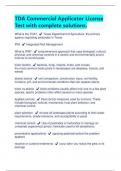TDA Commercial Applicator License Test with complete solutions. What is the TDA? ✔️ Texas Department of Agriculture, the primary agency regulating pesticides in Texas IPM ✔️ Integrated Pest Management What is IPM? ✔️ comprehensive approach that uses biological, cultural, physical, and chemical controls in a careful and environmenta lly sound manner to control pests biotic factors ✔️ bacteria, fungi, insects, mites, and viruses the most common biotic pests in landscapes are diseases, insects, and weeds abiotic factors ✔️ soil compaction, construction injury, soil fertility, moistu re, pH, and environmental conditions that can weaken plants biotic vs abiotic ✔️ biotic problems usually affect only one or a few plant species, abiotic problems often affect several or many species applied controls ✔️ Pest control measures used by hum ans. These include biological, cultural, mechanical, host plant selection, and chemical control. plant selection ✔️ choose all landscape plants according to their water requirements, shade tolerance, and susceptibility to pests chemical control ✔️ Use of pesticides or herbicides to manage an unwanted organism(s) (photo: herbicide used to kill dandelions) preventative applications ✔️ applying pesticide before the problem appears reactive or curative treatments ✔️ occur after you notice the pest or its damage protecting water resources ✔️ always use pesticides and herbicides as instructed pesticide movement ✔️ lateral movement with runoff or sediment; leaching into saturated zone; must be water soluble; also significant transport by wind and rain drift ✔️ the unintended movement of pesticides through the air during or after application to an area other than the intended target runoff ✔️ movement of pesticides across the treated surface when they fall on an impervious sur face such as a sidewalk or parking lot and contaminate the runoff water leaching ✔️ when chemicals move downward through the soil in the water pesticide residue ✔️ the trace amount of pesticide that remains in the environment after it is applied pesti cide degradation ✔️ all pesticides break down, or degrade, after application the speed of degradation depends on the chemical structure and other environmental factors such as moisture, temperature, and sunlight resistance management ✔️ steps taken by a pplicators to avoid or reduce the effects of pesticide resistance pesticide adjuvants ✔️ products designed to make pesticides more effective such as: surfactants (wetting agents reduce surface tension), stickers (makes pesticide remain on plant longer), colorants or dyes (mark areas that have been sprayed) insect pests of ornamentals ✔️ sucking pests, chewing pests, beetles, miscellaneous, wood -boring insects, & gall -forming pests sucking pests ✔️ aphids, scales, mealybugs, whiteflies, lace bugs, cicadas, thrips, spider mites signs of sucking pests ✔️ when foliage is bleached, bronzed, stippled (flecked), or yellowed but leaf surface looks physically sound




